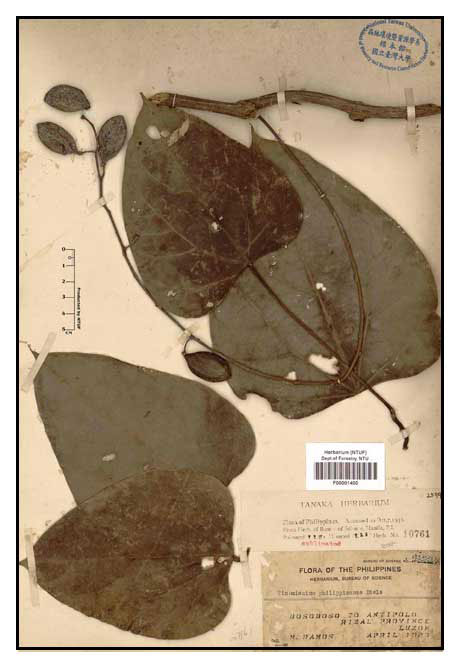 Botany Botany
Bayating is a stout, woody vine. Stem has a gray bark and milky sap. Leaves are thin, ovate, 15 to 25 centimeters long, and about 10 centimeters broad, smooth except at the nerves beneath, with a broad rounded base and pointed tip on long petioles, up to 15 centimeters in length. Flowers are yellow, fragrant, about 1 centimeter across, occurring in considerable numbers on long, slender, drooping branches which grow in clusters, usually on the stems.
Distribution
- Endemic.
- Found in Pangasinan, Quezon, and Laguna Provinces in Luzon; in Lanao and Davao Provinces in Mindanao, in forests at low and medium altitudes.
Constituents
- Yields a crystalline compound, Picrotin, a tutinolide sesquiterpene lactone.
-
A bitter principle has been isolated from the seed of Tinomiscium philippinense, Anamita cocculus, Menispermaceae, composed of one mole of picrotoxin and one mole picrotin into which it readily separates. (see study below) (8)
- Picrotoxin may also be used as an antidote to barbiturates. (5)
- The diterpene tinophyllone was isolated from the root and bark. (9)
Properties
- Picrotoxin has been reported to have CNS stimulant effect, insecticidal and nematocidal properties.
-
Studies have suggested antiangiogenic, antibacterial properties.
Parts used
Sap, fruit.
Uses
Folkloric
- White milky sap diluted with water used as eyewash. (7)
Others
• Fish poison: Fruit used as fish poison.
Studies
• Crystalline Principle / Constituent: Roots yielded a crystalline principle in the form of white needles. On elementary analysis and molecular weight determinations lead to the molecular formula C21H26O6. A tertiary phenolic alkaloid and a quaternary base are also present in the roots. (2)
• Tinophyllone: Study isolated tinophyllone, a diterpenoid, with a formula of C21H26O6.
• Anti-Angiogenic / Antibacterial / Toxicity Evaluation / Leaves: Study evaluated the toxicity profile, anti-angiogenic and antibacterial activity of crude and semi-crude leaf extracts of T. philippinense. A dichlormethane leaf extract at 1000 µg/disc showed the highest antiangiogenic activity with 37.46% inhibition. All fractions exhibited bacteriostatic and bactericidal effect on three bacterial strains, with P. aeruginosa showing higher sensitivity to the dichlormethane semi-crude extract. The ME of leaves was non-toxic at maximum dose of 5000 mg/kg. (4)
- Picrotoxin / Statement of Hazardous Nature: A bitter principle has been isolated from the seed of Tinomiscium philippinense and Anamita cocculus, composed of one mole of picrotoxin and one mole picrotin into which it readily separates. It was used therapeutically as a central and respiratory stimulant; as an antidote to barbiturate poisonings, now considered dangerous. Report presents an emergency overview, risks, potential health effects, acute health effects. Picrotoxin may cause severe toxic effects if swallowed; animal experiments have shown less than 5 grams may be fatal. At high doses, it is neurotoxic. Report presents basic and advanced treatment principles. (8)
Availability
Wild-crafted.
|

![]()



 Botany
Botany